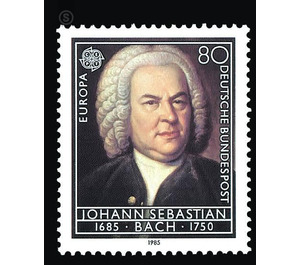Europe - Germany / Federal Republic of Germany 1985 - 80 Pfennig
Theme: Art & Culture
| Country | Germany / Federal Republic of Germany |
| Issue Date | 1985 |
| Face Value | 80.00 |
| Color | black |
| Perforation | K 13 3/4: 14 |
| Printing Type | 4-color rotogravure |
| Stamp Type | Postage stamp |
| Item Type | Stamp |
| Chronological Issue Number | 1122 |
| Chronological Chapter | GER-BRD |
| SID | 648316 |
| In 87 Wishlists | |
The year 1985 has been declared by the Council of Europe and the European Communities as the "European Year of Music". In the context of the XI. At the Ordinary General Assembly in Vienna, the European Conference of Postal and Telecommunications Administrations (CEPT) has selected the common theme of music for the European brands in 1985. On the occasion of her 300th birthday the work of the musicians Johann Sebastian Bach and Georg Friedrich Händel will be honored. The stamps show portraits of paintings by E.G. Haußmann, 1748 (Johann Sebastian Bach), and Thomas Hudson, 1749 (George Frideric Handel). In 1985, the birthdays of George Frideric Handel, Johann Sebastian Bach and Domenico Scarlatti for the 300th time. On this occasion, the Council of Europe and the European Community proclaimed 1985 the European Year of Music. In all European countries this year, the importance of music for society should be emphasized, the common foundations of European music in past and present made aware and a better framework for music life created in the future. The National Committee of the Federal Republic of Germany has called on all those who act as professional and amateur musicians or otherwise shape musical life to help achieve the goals of the European Year of Music, to attract more people to music, and to ensure that that the important role of music for the individual and for society as well as for the understanding among peoples will be particularly evident this year. The aim of the initiative is: - to awaken the understanding of many people for the music of all countries and epochs in their different styles and idioms, especially of contemporary music, as a component and expression of a common cultural heritage, - as many people, especially children and adolescents, to make active music-making, - to be aware of problems and deficits in the musical life of the public and politicians, to work out solutions and to create the necessary conditions for the further development of the musical culture, - to draw attention to the dangers of the misuse of music for manipulative purposes or go out by continuous sprinkling with music. These are the aims of the three composers whose birth anniversaries gave rise to the European Year of Music in 1985: the works of Bach, Händel and Scarlatti in their impact on European music history and its reception to the present day in practical music life, such as To highlight the musicological research, is the concern of many activities this year. These composers can be regarded as exemplary representatives of a common European musical culture; her works are testimonies to the connection between art and spiritual life across state borders, to exchange, open-mindedness to other styles and artistic directions and for mutual influence. (Text: National Committee of the Federal Republic of Germany for the European Year of Music 1985, office, Bonn)


